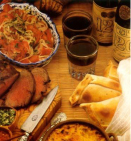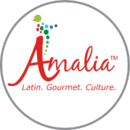
Chilean Panorama
 Although it appears slim and small, Chile is a long and narrow country about the size of Texas, with a vast coast line covering about 3,998 miles. The Pacific Ocean borders to the west; Argentina is a neighbor to the east; Bolivia, to the northeast; and Peru, to the north. Because of its geographical location, Chile has an unusual and fun landscape, with deserts, beaches, fjords, glaciers and icebergs, fertile lands, the Andes mountains, over 600 volcanoes (some active), and sub-artic conditions in the South. Since Chile is below the equator, their seasons are different from ours in the United States. So, when we have winter they have summer, and so on.
Although it appears slim and small, Chile is a long and narrow country about the size of Texas, with a vast coast line covering about 3,998 miles. The Pacific Ocean borders to the west; Argentina is a neighbor to the east; Bolivia, to the northeast; and Peru, to the north. Because of its geographical location, Chile has an unusual and fun landscape, with deserts, beaches, fjords, glaciers and icebergs, fertile lands, the Andes mountains, over 600 volcanoes (some active), and sub-artic conditions in the South. Since Chile is below the equator, their seasons are different from ours in the United States. So, when we have winter they have summer, and so on.
Even though Chile had years of political and economic turmoil, it has evolved into a market-oriented economy with strong foreign trade. Currently, it has the strongest economy in South America, with a relatively-low crime rate, and a high standard of living.
Chile is a land rich in beauty, culture, and literature. It is called “the Switzerland of South America” because of its natural splendor. World renowned poets, Pablo Neruda and Gabriela Mistral, won Nobel Prizes. The majority of Chileans are descendants of Europeans, namely Spanish, French, and German, and others in smaller numbers. Allegedly, the original inhabitants of the region prior to Spanish conquest were not natives but merely nomads who lived in the area. Their descendants are today about 3% of the population. A mixture of the so-called natives and European settlers is called “mestizo.” Today’s mestizos are so well blended that they look mostly European.

- Population about 15 million
- Capital Santiago
- Language Castilian Spanish
- Religion Roman Catholic (89%) and others (11%)
- Currency Chilean Peso ($1 USD = 515.00 Chilean Pesos)
- Independence Day September 18
- Fútbol (soccer) is most popular sport
- Flag Facts: Est. October 18, 1817. The flag is modeled after the U.S. Stars and Stripes. Blue represents the color of the high-mountain skies; white is symbolic of the snow in the Andes Mountains; and red symbolizes the blood shed during the long fight for freedom. Torres del Paine National Park, Chile
- Climate is extremely varied, and changes from region to region, and it ranges from mild in thespring months to dry and hot, and cool evenings, in the summer, with high temperatures reaching 85°F. During the fall, the highest temperature is about 60°F. Winter time is colder with heavy rains and snow in the mountains.
CHILEAN GASTRONOMY CHARACTERISTICS

Chilean cuisine is mostly European in nature, with heavy influences from Spain and France. Prior to the arrival of Columbus in the New World, Chilean food depended on what was produced locally. Local products come from natural resources and rely on climate and cultivating techniques to thrive. Many of these products remain staples today, namely fish, seafood, corn, beans, squash, chiles, tomatoes, and other native vegetables, roots, herbs, and spices. When the original fare met new ingredients brought by the Spaniards, (beef, lamb, pork, chicken and their by-products, and other non-native fruits, vegetables, and spices), and peoples from both Spain and France and other European countries began to settle in the area, the local cuisine evolved into a fusion of new flavors, textures, techniques, and cultures.
Chilean cuisine is healthy and varied. Many of the traditional dishes are a mixture of native and non-native ingredients, including grains, legumes, eggs, vegetables, and fruits, complemented with mostly seafood. Pork and chicken are popular and beef is eaten rarely, unlike their Argentinean neighbors. Chile peppers of various types are widely used. Sauces such as Pebre (various versions of spicy salsas), Chancho en piedra(Chilean hot green pepper salsa), and Color Chileno (Chilean paprika oil) are commonly used to complement, finish, add flavor and give eye appeal other dishes, like grilled meats, seafood, or vegetables. Their gastronomy continues to evolve, as in other countries, due to changes in migration, new tastes, new imports (ingredients and techniques), all which contribute to further transform the cuisine.
The Spaniards also brought vines to Chile. Through the years, Chile has emerged as a world-class wine producer. Although wine is widely popular, Pisco (grape brandy) is the adult national drink. Herbal teas of many varieties are also quite popular. Wine, seafood, fruits, and vegetables are important products of good quality that Chile also exports to other countries. The U.S. is their #1 trading partner.
Dishes vary from region to region. Some traditional favorites are Empanadas de horno (meat turnovers with beef, hard-boiled eggs, onions, olives, and raisins), Pastel de choclo (a baked meal of beef, chicken, onions, corn, eggs, and spices), Cazuela de ave (chicken soup), Ensalada chilena (cold tomato-and-onion salad), and seafood casseroles and stews. Porotos Granados (a stew of three types of beans, corn, and squash), and Pastel de Choclo Chileno (Chilean corn torte) are Chile’s national dishes. There are other variations of these stews as sausages, pork, or chicken are added. Another popular dish is Sinfonia del Mar (seafood symphony), a delicate stew of Spanish roots containing a mixture of seafood and vegetables, nuts, spices, and spirits. Cochayuyo, a delicacy seaweed native to the area is widely used in dishes such as Charquican de Cochayuyo (seaweed braised with vegetables.)
CHILEAN CULTURAL TRAITS

Chileans are well-educated and refined with a sharp and sometimes cynical sense of humor that often is misconstrued by other countries as “arrogance.” Respect and courtesy are very important to them. As such, they address people in the formal way as “usted”, instead of “tú”, a familiar way used in other Latin countries. When meeting someone for the first time, it is polite and common to shake their hand. For friends and relatives it is common to greet each other with a hug and a kiss on the cheek at arrival and departure time. Some common phrases used are ¿Qué tal? (What’s going on?), ¿Cómo estai? (How are you?), ¡Gusto de verte! (Nice to see you!), and ¿Qui’ubo? (What’s up?).
Good table etiquette is important, and it is considered rude to leave right after eating. Family, and extended-family time at the table is to catch up with each other and to spend some quality time. Literacy rate is in the high ninety percentile and secondary education is high. Chileans like to dress well and are very mindful of their personal appearance. As in many Latin countries, punctuality is taken lightly, unless you go to a business meeting.
Although all Latin Americans speak Castilian Spanish, some terms common to Chile do not have the same meaning elsewhere. To name a few, choclo (mature corn), Porotos (beans), chochayuyo (seaweed), and onces (afternoon teatime.) Likewise, they add –ito or –ita to many words and names to show affection. Carlos becomes Carlitos, meaning little Carlos, or dear Carlos. Professionals and elders are treated with utmost respect and titles are important, i.e. a lawyer is addressed as Licenciado Carlos; an elder person is called Señor or Don Carlos. Most people have a first, middle, and two last names. The first last name comes from the father and the second one from the mother. Married women often times have three last names, as in Maria Luisa Cabrera Maldonado de Perez. The word “de” means that she is married to someone with the last name Perez.
Lastly, the Cuenca is Chile’s national dance, reflecting both Spanish and native heritage. The Cuenca is arhythmic dance of courtship. Tonadas is Chile’s folk music. To make music, Chileans use many instruments of native and European origin to create unique sounds.
About the author
 Amalia Damgaard is a Guatemalan native, a professional chef, and a graduate of Le Cordon Bleu, with a Masters in International Business from St. Louis University. She runs and manages a private chef business that specializes in presentations featuring Latin American and international gourmet cuisine, culture and history. Amalia lives in Eden Prairie, Minnesota.
Amalia Damgaard is a Guatemalan native, a professional chef, and a graduate of Le Cordon Bleu, with a Masters in International Business from St. Louis University. She runs and manages a private chef business that specializes in presentations featuring Latin American and international gourmet cuisine, culture and history. Amalia lives in Eden Prairie, Minnesota.
Resources: World Atlas, The Food Lovers Atlas of the World, Culture Grams, The South American Table, Secrets of South American Cooking, and the Art of South American Cooking.
